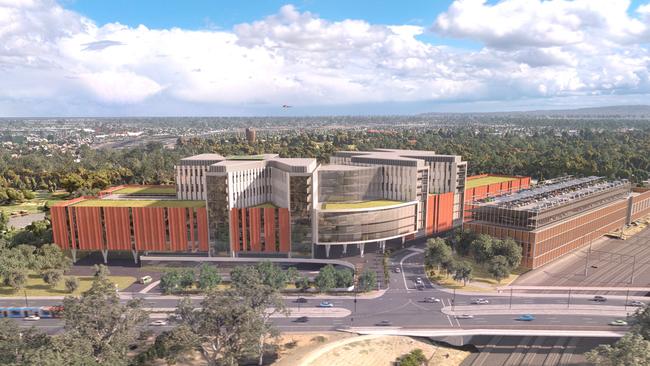Eye-watering cost per bed at new $3-3.2 billion Women’s and Children’s Hospital revealed
The new Women’s and Children’s Hospital will be Australia’s most expensive building – and with a staggering cost per bed revealed to be almost three times more than the RAH.
SA News
Don't miss out on the headlines from SA News. Followed categories will be added to My News.
Australia’s most expensive building, the $3.2bn new Women’s and Children’s Hospital, will cost almost three times the state’s flagship Royal Adelaide Hospital on a per bed basis — and eight times as much as South Australia’s largest private hospital.
However as the Opposition warns of blowout risks the government says it has future-proofed the huge build cost by including inflation values — although even the Reserve Bank Governor Philip Lowe admits he is now “soul searching” after misjudging economic conditions.
Health Minister Chris Picton said he inherited a nWCH plan that was too small and set to blow out to $2.8bn while the new build will “deliver a bigger, better WCH with room to expand.”
“That cost is fully escalated to 2030-2031 dollars – meaning it also takes account of the expected inflation in costs over the next eight-to-nine years,” Mr Picton said.
“The nWCH build will have engineering which includes earthquake proofing, ability to maintain power in a blackout for long periods and self-sufficiency in the event of a disaster.”

Mr Picton said there will be cost controls and external expert advice to ensure the most efficient use of taxpayers’ money.
Opposition health spokeswoman Ashton Hurn warned: “Based on Labor’s track record with the RAH you’d have to say there’s an enormous risk the new WCH will spiral out of control with further delays and cost blowouts.”
The nWCH comes in cheaper per bed than some other Australian hospitals now on the drawing board — provided there are no cost blowouts.
The RAH with 800 beds eventually cost $2.44bn. It was $600m over budget and 17 months late and total cost works out to around $3m per bed.
The nWCH due to open in 2030-31 has a budget estimate of up to $3.2bn. With 394 beds and capacity for 20 more this works out at around $8m per bed.
When Calvary Adelaide Hospital opened in 2020 as the state’s largest private hospital, it cost $345m for 343 beds, or $1m a bed.
The RAH took the title of the nation’s most expensive new hospital from the $2 bn Fiona Stanley Hospital in Perth with 783 beds, or around $2.5m a bed.
The Queensland Children’s Hospital opened in 2014 with 359 beds at a cost of $1.2bn, or $3.3m per bed.
It is difficult to directly compare private hospitals with public hospitals.
Private hospitals often focus on elective surgery and low-risk birthing, while major tertiary public hospitals have large emergency departments and intensive care units, mental health units, renal units, cancer care, highly specialised equipment, major outpatient facilities, helipads and more.
There are a host of new or expanded hospitals planned in Australia where cost per bed estimates vary wildly.
Several are in the $1m-to-$2m per bed range so well under the nWCH, while others are well north.

The new Toowoomba Hospital is set to take the crown as the nation’s most expensive per bed hospital at around $11m per bed, followed by Bundaberg at nearly $10m per bed.
Factors including greenfields sites, remediation work, removal of toxic waste, demolition work, earthworks, property acquisitions, carparking, whether it is new or an expansion of an existing facility and much more impact on costs.
As will timelines. The nWCH will not open for almost a decade.
China reportedly took just 10 days to build the 1000-bed makeshift Huoshenshan hospital in Wuhan staffed by 1400 medicos to treat coronavirus patients in February 2020. The plan for the hospital was completed within five hours and a design draft within 24 hours.
China’s 1500-bed Leishenshan Hospital was also completed in 10 days in the same month.
Head of the Huoshenshan project, Chen Huayuan, overseeing a team of more than 40,000 workers from 100 different contractors “working in harmony” noted afterwards: “Cost was the least of everyone’s concerns.”
However, these were not planned for the next century — both have since closed.





